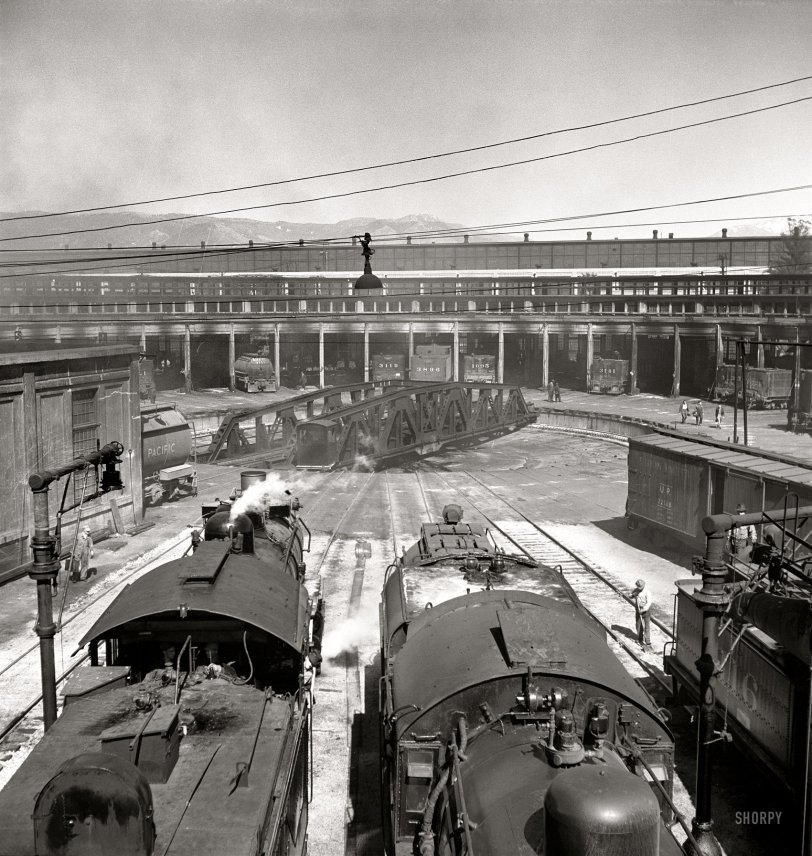


Framed or unframed, desk size to sofa size, printed by us in Arizona and Alabama since 2007. Explore now.
Shorpy is funded by you. Patreon contributors get an ad-free experience.
Learn more.

- Lofty addition
- In 1912
- Keenan Building
- Six years old
- Taken from the P.J. McArdle Roadway?
- It stood only 47 years
- Three track mind
- Incline to the right
- Reach for the sky, 1912 style
- No clean sweep
- Same Job Title, Same Face
- Sadly Lost
- Beautiful ...
- Where you get your kicks
- Aim High
- Pueblo Revival sisters
- Pueblo Neoclassicism
- Milk Man
- Regional dialect.
- Spielberg's inspiration
- Great Photo
- Loaf Story
- Do you still have the Rakes category?
- Could almost be a scene from the 1957 movie 'Hell Drivers'
- The Wages of Fear.
- Conspicuous by their absence
- Got Milk?
- All that aluminum
- No lefties
- Smoke 'em if you've got 'em
Print Emporium
Roundhouse: 1943

March 1943. "San Bernardino, California. Engines at the roundhouse." Nitrate negative by Jack Delano for the Office of War Information. View full size.
Santa Fe Steam
A decade later in 1953 Santa Fe stopped using steam locomotives in favor of diesel locomotives and never looked back
Santa Fe
Despite the presence of Union Pacific locomotives, this is actually the Santa Fe Railway's roundhouse in San Bernardino. The locomotives with numbers on the backs and sides are Santa Fe locomotives, as they were typically marked back then. The turntable design matches Santa Fe turntables in Barstow and Bakersfield. Union Pacific connected to Los Angeles via a trackage rights agreement with the Santa Fe, and engines were serviced at Santa Fe facilities.
In my book "Decade of the Trains" there are three pictures of this same facility, at least two of which must have been taken on the same day by the same photographer.
The Roundhouse
The photos you see of steam locomotives facing out on the outside "garden" tracks are usually those that have already been serviced. Engines on the inbound lead get fueled, watered, sanded, and usually washed before heading inside for inspection and light repairs. Some, but not all, roundhouses have inspection pits on all inside tracks and are usually configured for the engine to be facing out toward the roundhouse wall and the tender toward the turntable. Of course, the engines are moved and turned as needed, and there may be special stalls for certain jobs. After servicing, the engines are lined up on the outbound lead if needed soon or stored on garden tracks. That is the usual procedure.
I am among the youngest Americans to have witnessed steam in the late 1950's on the UP, NP, GN, and CP. In the early 1970's I saw lots of steam on the Deutsch Bundesbahn when I was stationed in southern Germany.
1943 was not the waning days of steam. The Santa Fe was not only buying diesels, but they were still buying new steam into 1943-44. The last year for ATSF steam in wide service was 1953. There was peak season steam freight and helper service in 1954-55 and helper service in NM in 1956-57. Notice the oil columns in the foreground: all the steam here is oil rather than coal-burning.
Circular logic
My dad used to quote a vaudeville line, involving someone trying to escape from the police:
"Head for the roundhouse, Harry! They can't corner you there!"
He also used to say to me, "Stop yelling through the screen door, son. You're only straining your voice."
A laff riot, my Dad was.
Labor
I can find 16 railwaymen in this photo
Back 'er right in!
I work in a roundhouse on the Long Island R.R. We bring the diesels in either way, depending on the work being done.
Working
This is a photo of a roundhouse where real work is being done. So many photos of roundhouses have the locomotives "facing" out - headlights and the front of the boilers facing the camera, not unlike a class picture - but of course at a roundhouse you can't service a locomotive facing in that direction. There's no space to work around it and and the servicing pits don't wouldn't be in the right position. In my days of reading model railroading magazines I read stories from real railroad old-timers who talked about those photos and how disruptive they were to actually getting work done because it would take hours to turn the locomotives to the desired position get the photo and then turn them back the way they were supposed to be.
Labor intensive
This great photo really points up the fact that railroading pre-diesel, pre-intermodal, was highly labor intensive. The picture teems with "workin' men." We had a roundhouse and steam engine repair facility in our town back in the early part of the 20th Century, on the CNW, that employed thousands and kept our population near 5,000. In the Year of Our Lord 2009, the population is 2,850. Now, we are a "division point" on the Union Pacific mainline, but we're not teeming with "workin' men!" Even the cabooses are gone.
Steam Dreams
An epic shot from the glorious, but already waning, days of steam. Don't miss the engineer & fireman peering back from the cab of the steamed-up engine at foreground left.
























On Shorpy:
Today’s Top 5